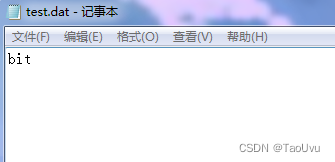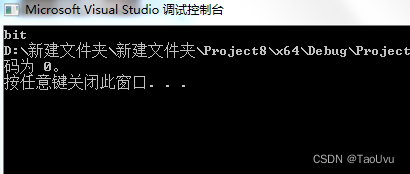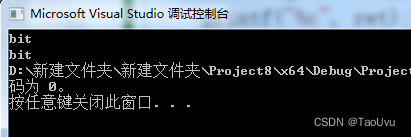一、为什么使用文件?
当我们写通讯录程序录入信息时,程序一退出,所有的信息都消失不见了,下一次运行通讯录时又要重新录入信息,通讯录的可利用率大大降低,所以为了实现数据的持久化,就必须使用文件操作,把信息存储到磁盘中。
二、什么是文件
磁盘上的文件就是文件。
程序文件包括源程序文件.c,目标文件.obj,可执行文件.exe。
数据文件的文件内容不一定是程序,而是程序运行时读写的数据,比如程序运行需要从中读取数据的文件,或者输出内容的文件。
文件名
一个文件要有一个唯一的文件标识,以便用户识别和引用。
文件名包含三部分:文件路径+文件名主干+文件后缀。
例如:c:\code\test.txt
三、文件的打开和关闭
文件指针
文件指针FILE *
FILE* pf//文件指针变量
文件在读写之前应该先打开文件,文件在使用完毕后需要关闭。
FILE* fopen(const char * filename,const char * mode);
int fclose(FILE* stream);
文件的顺序读写
fputc函数的功能可以把数据显示到屏幕上 把输入字符的保存在文件中。
int fputc(char c,FILE* stream);
#include<stdio.h>
int main()
{
FILE* pf = fopen("test.dat", "w");//往文件中写入内容
if (pf == NULL)
{
perror("fopen");
return 1;
}
//写文件
fputc('b', pf);
fputc('i', pf);
fputc('t', pf);
fclose(pf);
pf = NULL;
return 0;
}
往文件中顺序写入bit三个字符。

#include<stdio.h>
int main()
{
fputc('b', stdout);
fputc('i', stdout);
fputc('t', stdout);
return 0;
}
往标准输出流中写入字符。

fgetc函数的功能可以从文件中读入数据 输出至屏幕中。
#include<stdio.h>
int main()
{
FILE* pf = fopen("test.dat", "r");//往文件中读出内容
if (pf == NULL)
{
perror("fopen");
return 1;
}
//读文件
int ret = fgetc(pf);
printf("%c", ret);
ret = fgetc(pf);
printf("%c", ret);
ret = fgetc(pf);
printf("%c", ret);
fclose(pf);
pf = NULL;
return 0;
}

fgetc从标准输入流读取信息
#include<stdio.h>
int main()
{
//fgetc从标准输入流读取信息
int ret = fgetc(stdin);
printf("%c", ret);
ret = fgetc(stdin);
printf("%c", ret);
ret = fgetc(stdin);
printf("%c", ret);
return 0;
}

fputs读入一行输入到文件中
#include<stdio.h>
int main()
{
FILE* pf = fopen("test.dat", "w");//往文件中写入内容
if (pf == NULL)
{
perror("fopen");
return 1;
}
//写文件
fputs("abcdef\n", pf);
fputs("ghi", pf);
fclose(pf);
pf = NULL;
return 0;
}
fgets读入一行输出到屏幕中
#include<stdio.h>
int main()
{
char arr[10] = { 0 };
FILE* pf = fopen("test.dat", "r");//往文件中写读出内容
if (pf == NULL)
{
perror("fopen");
return 1;
}
//写文件
fgets(arr, 4, pf);
printf("%s\n", arr);
fgets(arr, 4, pf);
printf("%s\n", arr);
fclose(pf);
pf = NULL;
return 0;
}
格式化输入函数
#include<stdio.h>
struct S
{
char arr[10];
int num;
float sc;
};
int main()
{
struct S s = {0};//把结构体的数据读出到文件中
//对格式化的数据进行读文件
FILE* pf = fopen("test.dat", "r");
if (pf == NULL)
{
perror("fopen");
return 1;
}
fscanf(pf, "%s %d %f", s.arr, &s.num, &s.sc);//往文件中读信息
printf("%s %d %f", s.arr, s.num, s.sc);//打印读到的信息
fclose(pf);
pf = NULL;
return 0;
}
格式化输出函数
#include<stdio.h>
struct S
{
char arr[10];
int num;
float sc;
};
int main()
{
struct S s = { "abc",10,5.5f };//把结构体的数据写入到文件中
//对格式化的数据进行写文件
FILE* pf = fopen("test.dat", "w");
if (pf == NULL)
{
perror("fopen");
return 1;
}
fprintf(pf, "%s %d %f", s.arr, s.num, s.sc);//往文件中写入信息
fclose(pf);
pf = NULL;
return 0;
}
fread 二进制读
#include<stdio.h>
struct S
{
char arr[10];
int num;
float sc;
};
//把结构体的数据以二进制的形式写入到文件中
int main()
{
struct S s = { 0 };
FILE* pf = fopen("test.dat", "r");
if (pf == NULL)
{
perror("fopen");
return 1;
}
fread(&s,sizeof(struct S),1,pf);//从文件中读出信息
//打印读出的信息
printf("%s %d %f\n",s.arr,s.num,s.sc);
fclose(pf);
pf = NULL;
return 0;
}
fwrite 二进制写
#include<stdio.h>
struct S
{
char arr[10];
int num;
float sc;
};
//把结构体的数据以二进制的形式写入到文件中
int main()
{
struct S s = { "abc",10,5.5f };
FILE* pf = fopen("test.dat", "w");
if (pf == NULL)
{
perror("fopen");
return 1;
}
fwrite(&s,sizeof(struct S),1,pf);//往文件中写入信息
fclose(pf);
pf = NULL;
return 0;
}
区别
scanf 针对标准输入的格式化的输入语句 stdin
fscanf 针对所有输入流的格式化输入语句 stdin/文件
printf 针对标准输出的格式化的输出语句 stdout
fprintf 针对所有输出流的格式化输出语句 stdout/文件





















 4万+
4万+











 被折叠的 条评论
为什么被折叠?
被折叠的 条评论
为什么被折叠?








